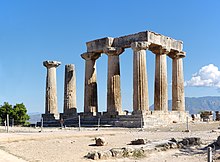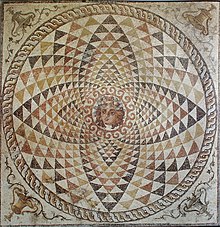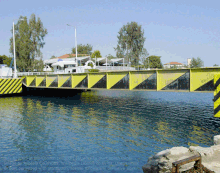Corinth or Korinth (Greek: Κόρινθος, Kórinthos) is one of the oldest towns of Peloponnese, a port and the capital of the homonym region.
Understand
[edit]
It is important to know that there is new Corinth and the ancient one. If you go to "Corinth" that usually means you are going to the new one, i.e. all the archaeological sites are not there, but a little outside the city (5 km).
Corinth has a population of 37,000.
The area is known to have been inhabited at least since 6000 BC. Nevertheless, little in the town reflects its old glories, since it has been hit severely by earthquakes, destroying most of its old constructions.
Get in
[edit]Upon entrance through Patras it is a convenient stop on the way to Athens or as a stop to explore the history-rich area.
Corinth is very close and easily approachable from Athens through most transport means, buses, trains, cars. Hourly suburban trains (Proastiakos) connect directly the city with Piraeus Port (railway line Kiato-Piraeus). A bus ticket from the bus station of Athens to the town of Corinth costs €9 as of February 2018. The 1 railway station is inconveniently located south of the city center.
There is an 2 intercity bus station near the sea and the "Aqua Park Water Fun", known as "KTEL Isthmou". It is a little hidden and probably hard to find at first, but just keep asking people for the bus stop.
If you are in old Corinth, first take a bus from there to the new Corinth and ask the bus driver how to get to Athens. If you are lucky, he will take you along to a bus station (which comes after the city center and most people will have left the bus by that time). At that bus station, you will easily find a bus to Athens.
Get around
[edit]If you want to go to the "old" Corinth (with all the archaeological sites and ruins, you can first go to the new Corinth and then take a bus from there to the old one. For that, you should go to the center of new Corinth and then ask people where the bus stop is. The bus stop should be located around a café, and the bus leaves every hour, 5 minutes after the hour. The bus says "APXAIA" for the destination and it will take you to the old part. You can buy a ticket in the bus (€1.80). It is a good idea to stay in the bus a little while it is going through the old Corinth, because it gives you a nice, cheap tour. You could for example get out at the ancient theater (just ask the bus driver).
See
[edit]



Most of the interesting and historical stuff is in old Corinth:
- 1 Ancient Corinth Archaeological Museum, ☏ +30 27410 31207. Winter: From 1/11 to 31/3, 08:00-15:00 Summer: From 3/4 to 30/4, 08:00-19:00. Tickets Full: €6, Reduced: €3 for both the Museum and the Archaeological Site.
- 2 Temple of Apollo. Built around 560 B.C.E. atop a rocky hill, the Temple of Apollo is one of the earliest Doric temples in Greece. It was restored In the Roman period and dedicated to the cult of the Emperor. In the Byzantine era was turned into a basilica, whereas in the Ottoman period was partly demolished and a new residence of the local Turkish Bey was built on top of its crepis. Today only seven standing columns are preserved.
- 3 Peirene Fountain. Pirene, a nymph who, according to legend, gave the name to the fountain. Poets would travel there to drink and receive inspiration.
- Ancient Theater.
- Roman Odeon. The Roman Odeion was constructed in the 1st century AD, while in the 3rd century AD it was converted into an arena.
- 4 Glauke Fountain. The Glauke Fountain was built near the Temple of Apollo in Roman times. According to tradition, Glauke, daughter of king Kreon, was about to marry the hero of the Argonauts Jason. A little before her wedding, Glauke received a poisoned peplos by Medea, which inflamed immediately after it was worn, In order to be saved, the girl fell in the fountain, which was named after her.
- 5 Acrocorinth (Ακροκόρινθος). "Upper Corinth", the ancient city's acropolis, a monolithic rock overseeing Corinth. Hailed as the most impressive of the acropoleis of mainland Greece, Acrocorinth was continuously occupied from archaic times to the early 19th century.
- 6 Corinth Canal (Διώρυγα της Κορίνθου, Dhioryga tis Korinthou). connects the Gulf of Corinth with the Saronic Gulf in the Aegean Sea, cutting through the narrow Isthmus of Corinth and separating the Peloponnese from the Greek mainland, arguably making the peninsula an island. The builders dug the canal through the Isthmus at sea level; no locks are employed. It is 6.4 kilometres (4 mi) in length and only 21.4 metres (70 ft) wide at its base, making it impassable for most modern ships. It now has little economic importance. The canal was initially proposed in classical times and a failed effort was made to build it in the 1st century CE. Its construction started in 1881 but was hampered by geological and financial problems that bankrupted the original builders. It was completed in 1893 but, due to the canal's narrowness, navigational problems and periodic closures to repair landslides from its steep walls, it failed to attract the level of traffic expected by its operators. It's now used mainly for tourist traffic. Interesting are the submersible bridges at both ends of the canal. The Isthmia Bridge at the SE end of the canal has the best facilities for watching the bridge sinking into the water, from one of the terraces.
Do
[edit]Buy
[edit]Eat
[edit]Drink
[edit]Sleep
[edit]Budget
[edit]- 1 Apollon Hotel, 2, Damaskinou Str, ☏ +30 27410 25920, fax: +30 27410 83875. 1-star hotel. 18 rooms, bath or shower
- 2 Ephira Hotel, 52, "Ethnikis Antistasseos" Str, ☏ +30 27410 22434, +30 27410 24021, fax: +30 27410 24514. 2-star hotel
- 3 Korinthos Hotel, 26, Damaskinou Str, ☏ +30 27410 26701, fax: +30 27410 23693, info@korinthoshotel.gr. 2-star hotel


